Mendoza, Argentina
Wine Country
Mendoza is wine country! Here, hundreds of vineyards and countless rows of grape vines blanket the landscape beneath the backdrop of the Andes Mountains. The most notable wines of the many produced across the region are Malbecs and Cabernet Franc.
Wine Tour by Bicycle
There are multiple wine producing regions in Mendoza known for different varieties of grapes and wines. We visited the Maipu and Lujan de Cayo valleys on a self guided bike tours. Both valleys have a range of vineyards in close proximity to each other making it easy to visit multiple in one day. It’s also the most affordable way to visit the vineyards.
Maipu Bikes. A bike rental company in the center of the Maipu Valley with daily bike rentals, route suggestions, a map and vineyard discounts. They’re open from 10am-6pm with a free happy hour between 5-6pm. The cost is $10 ARS in cash only.
Baccus Wine Tours. A bike rental company in the Lujan de Cayo Valley with daily bike rentals, route suggestions and a map. They’re open from 10am-6pm daily. The cost is $15 ARS in cash only.
Good to Know
It’s best to start between 10-11am and plan out a route to maximize time.
If planning to visit any specific wineries, confirm hours and the need for a reservation before arriving.
Plan to visit anywhere from 2-5 vineyards depending on pace.
Order a meal for lunch or pairings throughout the day.
Bring water to stay hydrated!
Wear sunblock, Mendoza is technically a desert and the UV often reaches extreme levels.
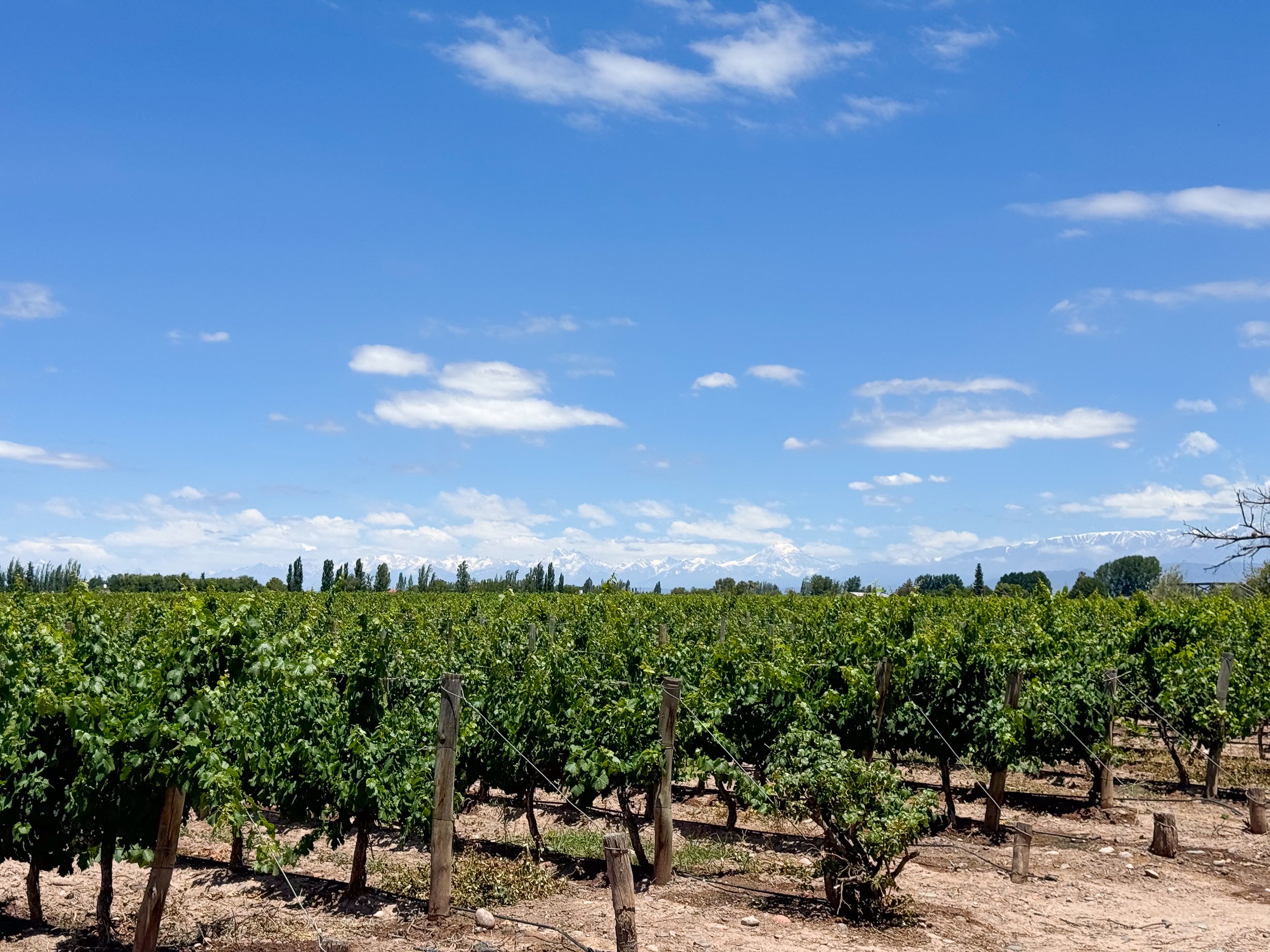
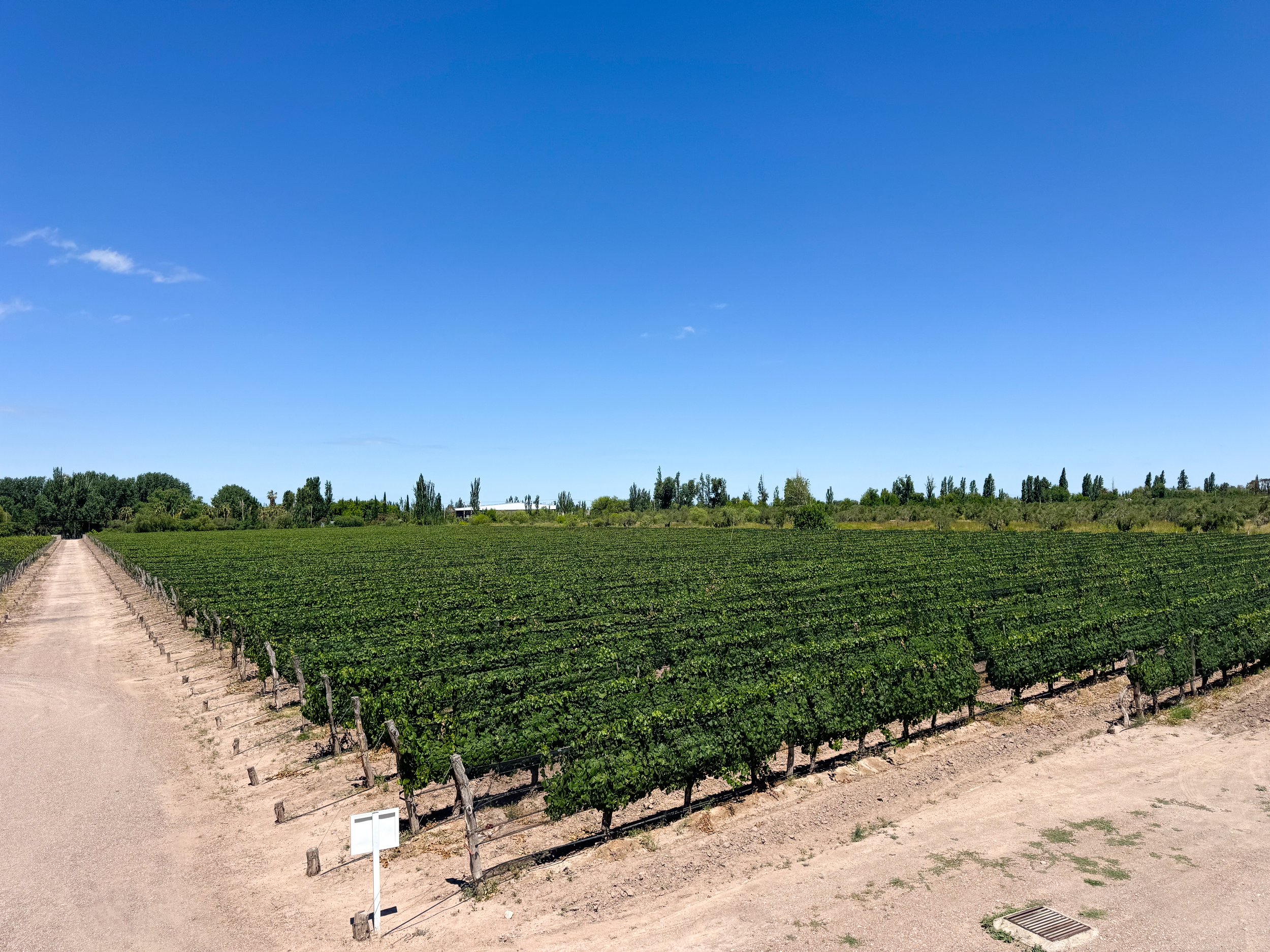
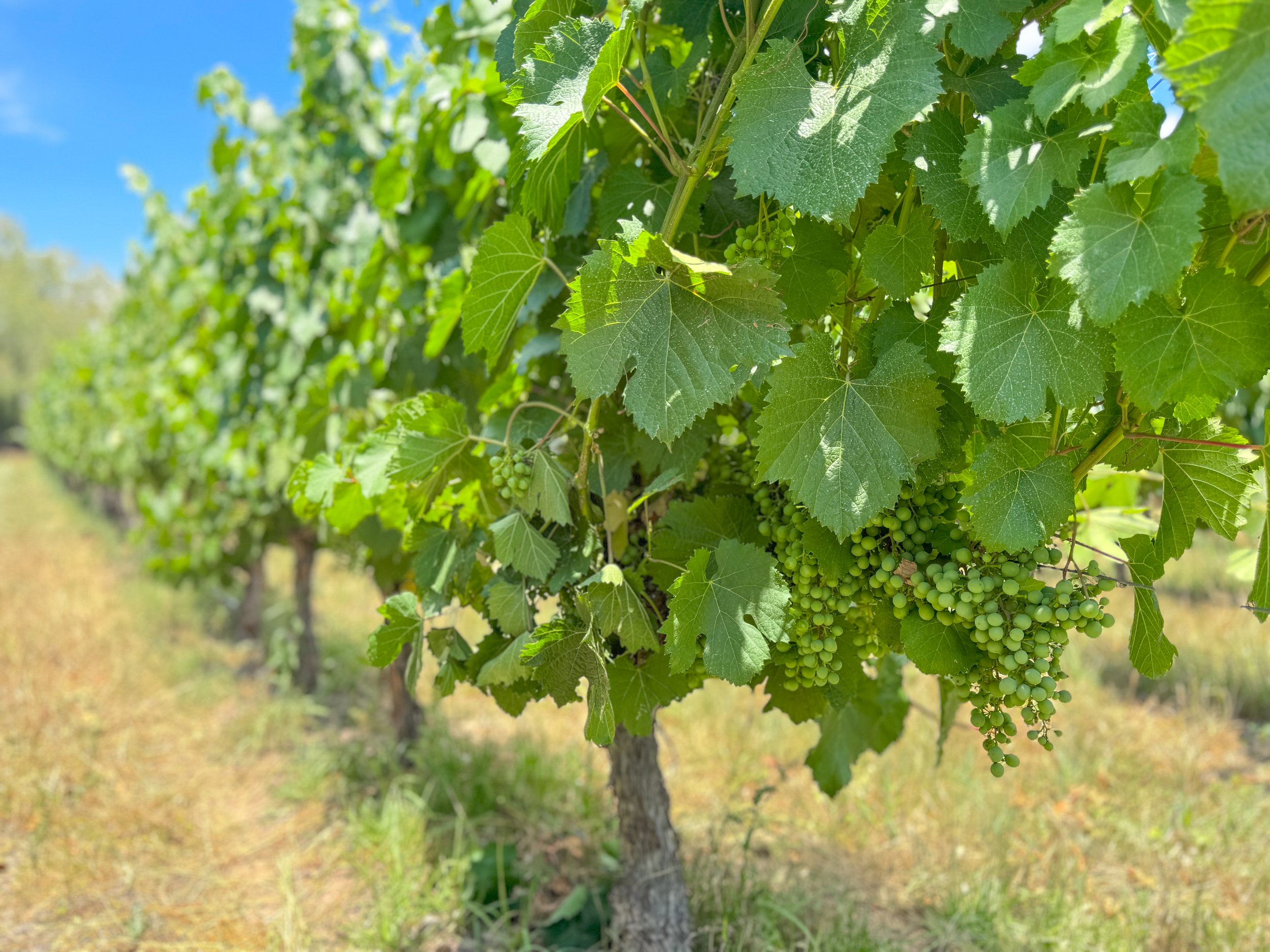
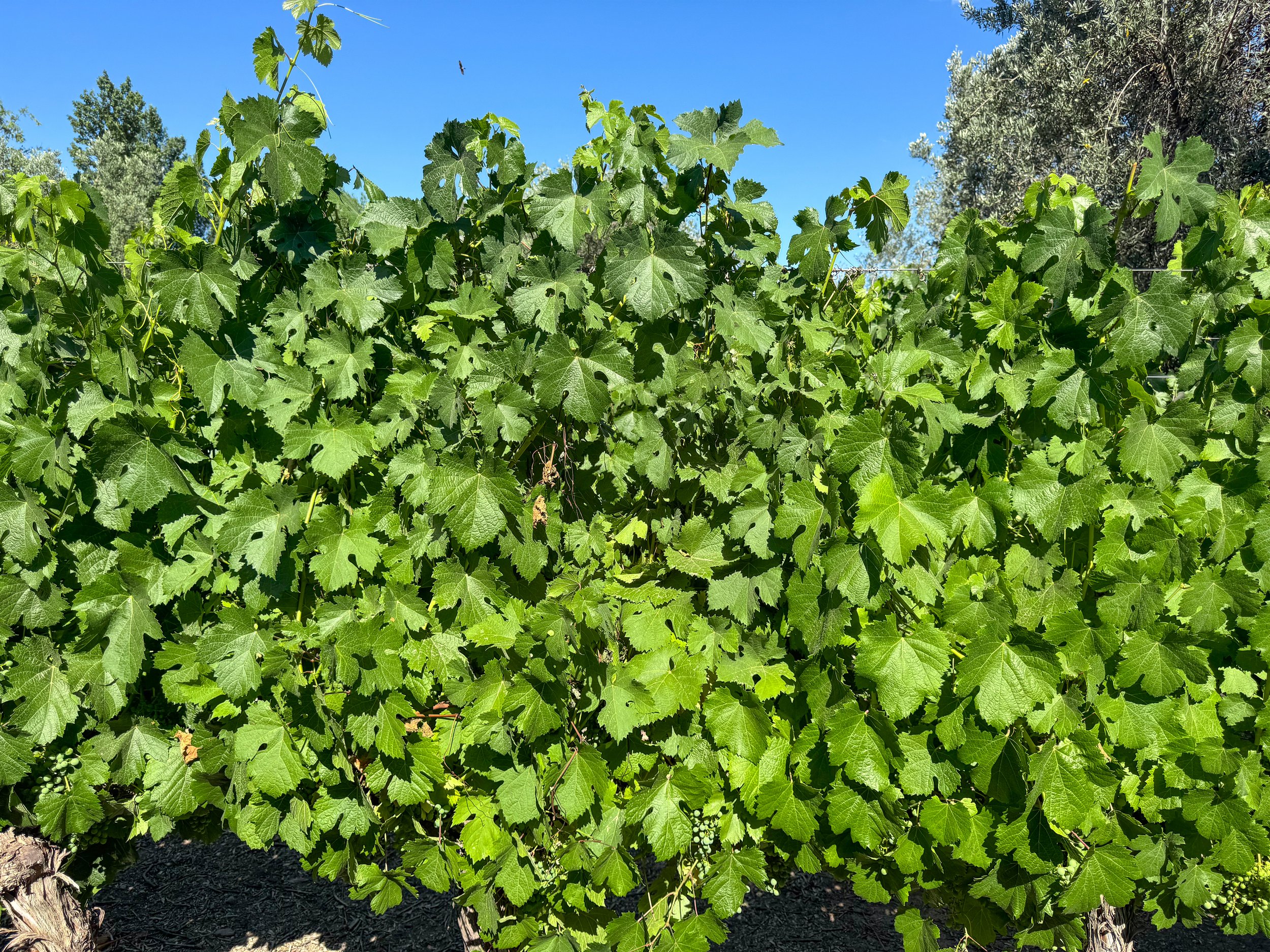
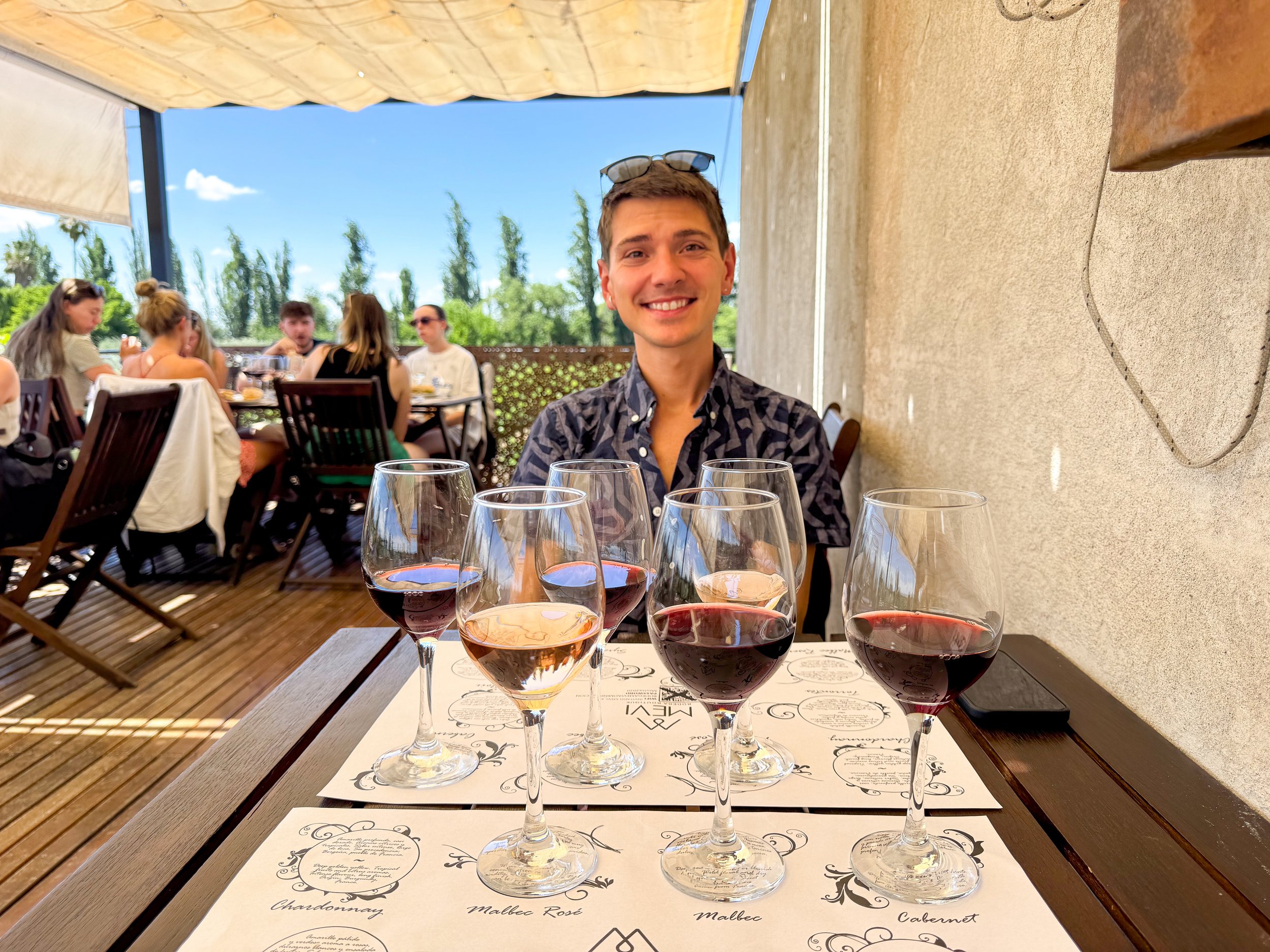
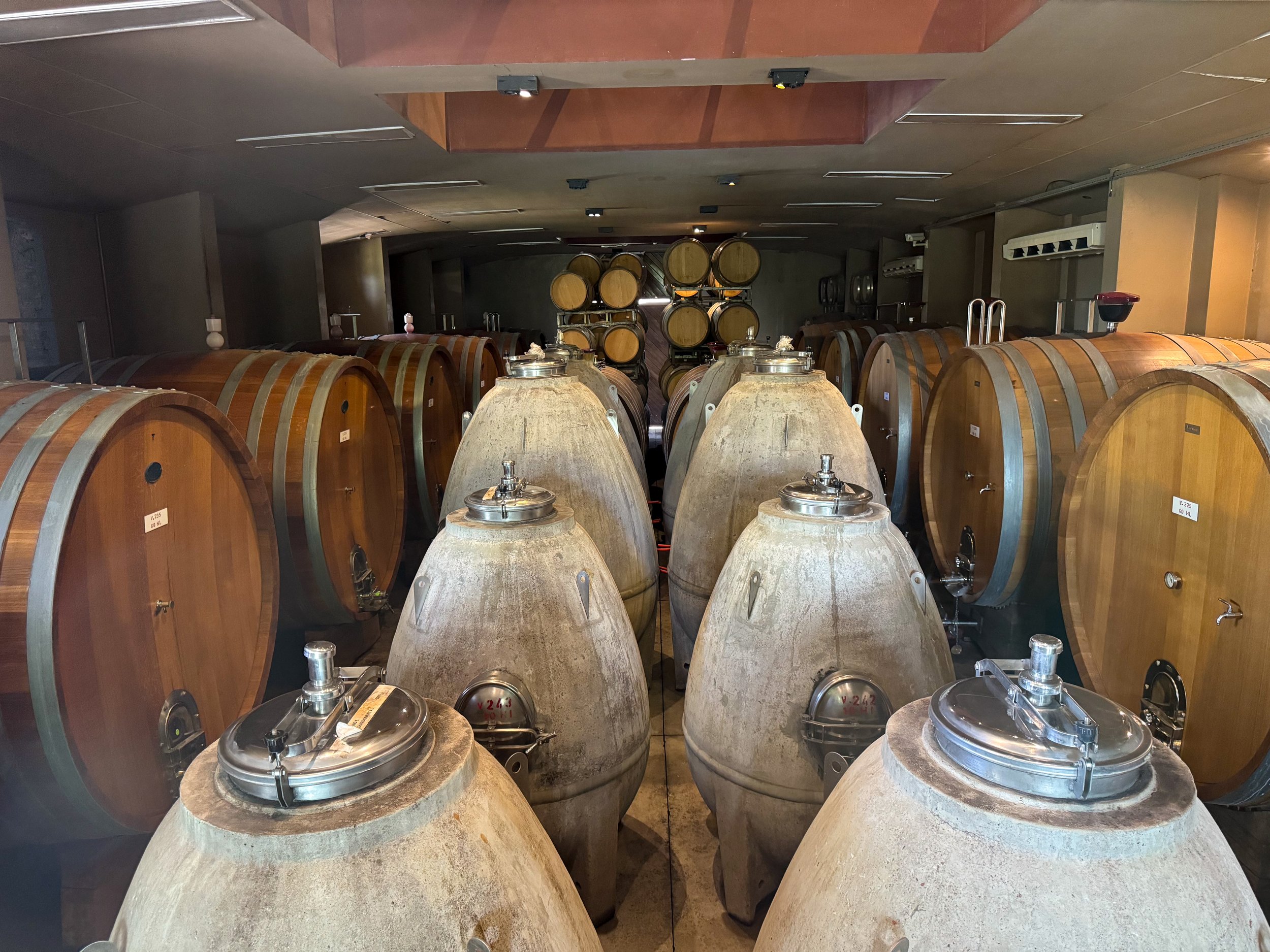
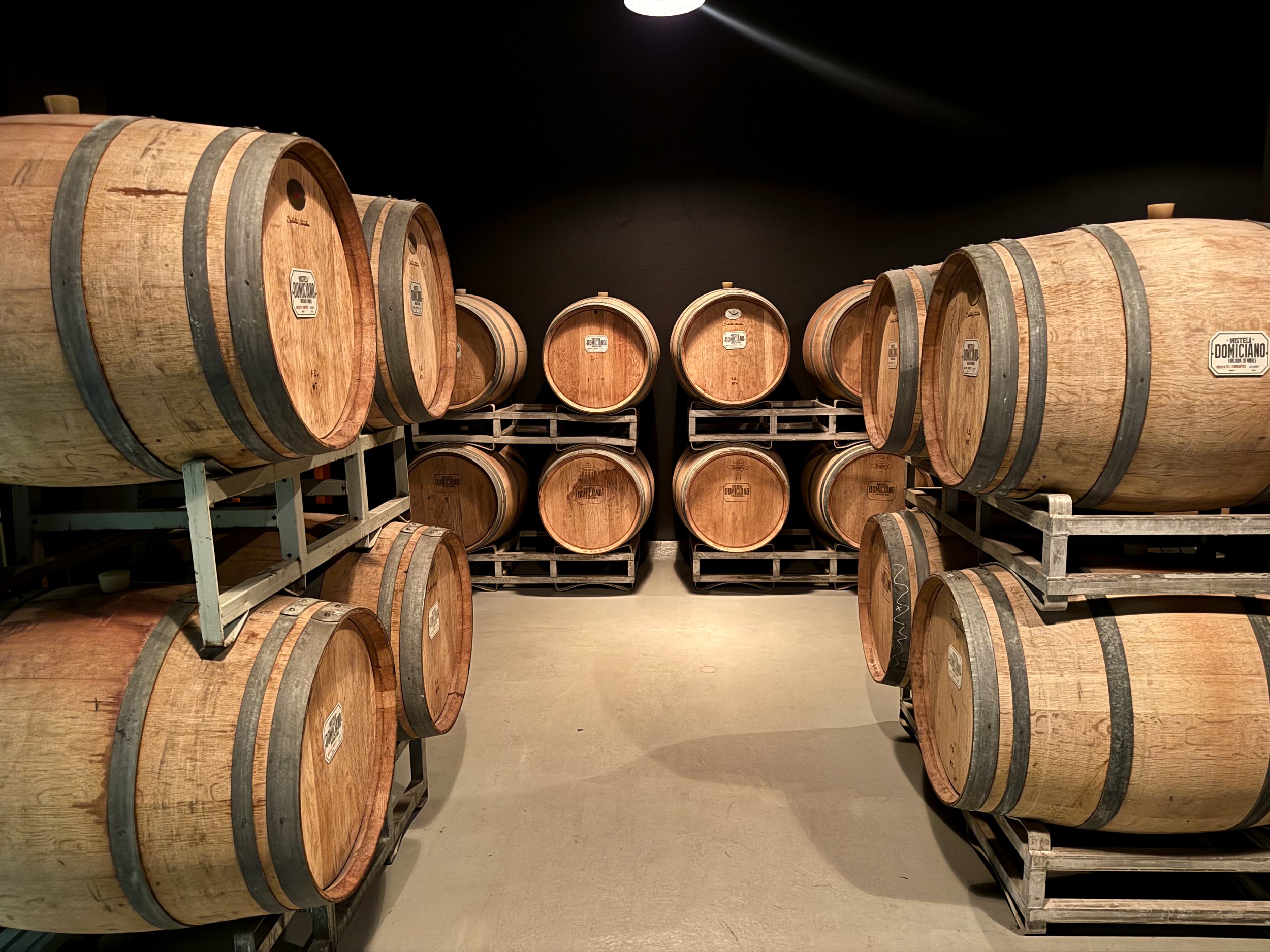
The Maipu Valley
A slightly industrial wine producing valley southeast of Mendoza with many large scale and boutique vineyards. Roadside bike paths follow the main road and branch off onto dirt roads leading to most vineyards. We visited 4 vineyards and an olive oil store during our tour.
Bodega Trapiche. A grand and historic vineyard with tours, tastings and opportunities to learn about the winemaking process. Our tour started with a stroll through the vineyard with a glass on small batch white wine only served onsite. We transited to a Malbec as we entered a warehouse with massive concrete tanks used to store thousands of liters of wine. The next building housed aerobatic oak barrels and concrete eggs of aging wine. We ended our tour in their tasting room with views of the andes, sampling two more Malbecs, both grand reserves. The vineyard is bike friendly, it’s pricer to visit and reservations are required.
Entre Olivos. A small shop with tastings of locally produced olive oils, olive pates and wine. We stopped here in route to the next vineyard and bought a bottle of oil to bake focaccia.
Viña el Cerno. A small vineyard with a tasting room in there processing warehouse. We didn’t learn much about the vineyard or their wines but got to sample three different types, a sweet rosé, Cabernet Franc and Merlot. The vineyard is bike friendly and no reservations are needed.
Bodega MEVI. A vineyard with a restaurant and tasting room overlooking their rows of grapes vines, olive trees and the snow covered Andes. We didn’t learn much about the wines but enjoyed the view while drinking them. We sampled three types, a dry rosé, Cabernet Franc and Merlot. The vineyard is bike friendly and no reservations are needed.
Bodega Domiciano. A winery with a small show vineyard at their production facility. We toured the vineyard with rows of Sarah, Merlot and Cabernet grapes, getting to learn about the vines themselves. Inside their warehouse, we walked past large concrete tanks used to store thousands of liters of wine then to their cellar with oak barrels and bottles of aging reserves. Our tour ended in their tasting room where we sipped on a Sparking Brut, Malbec and Syrah. The vineyard is bike friendly, no reservations are needed however tours happen at set times throughout the day.
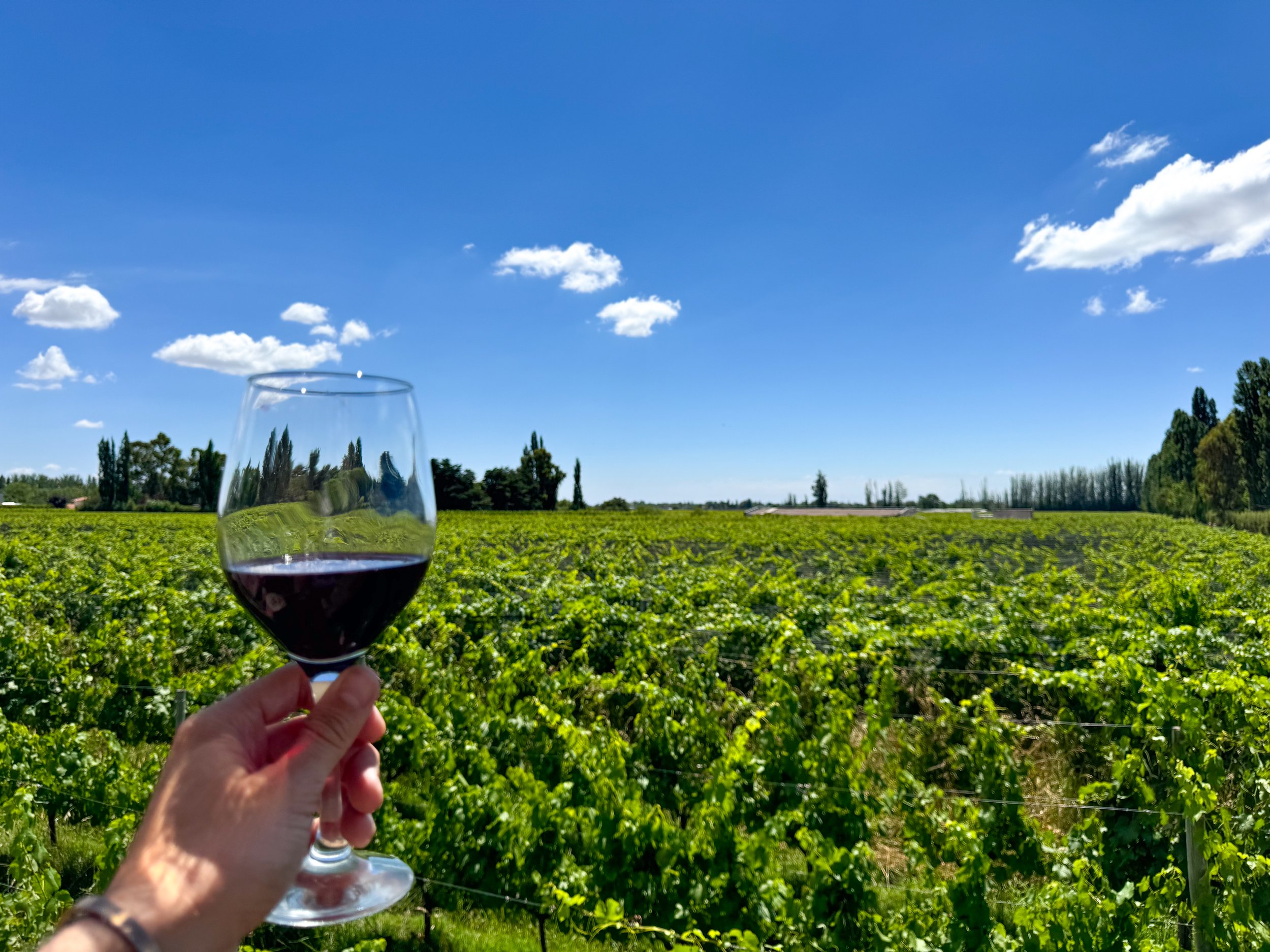
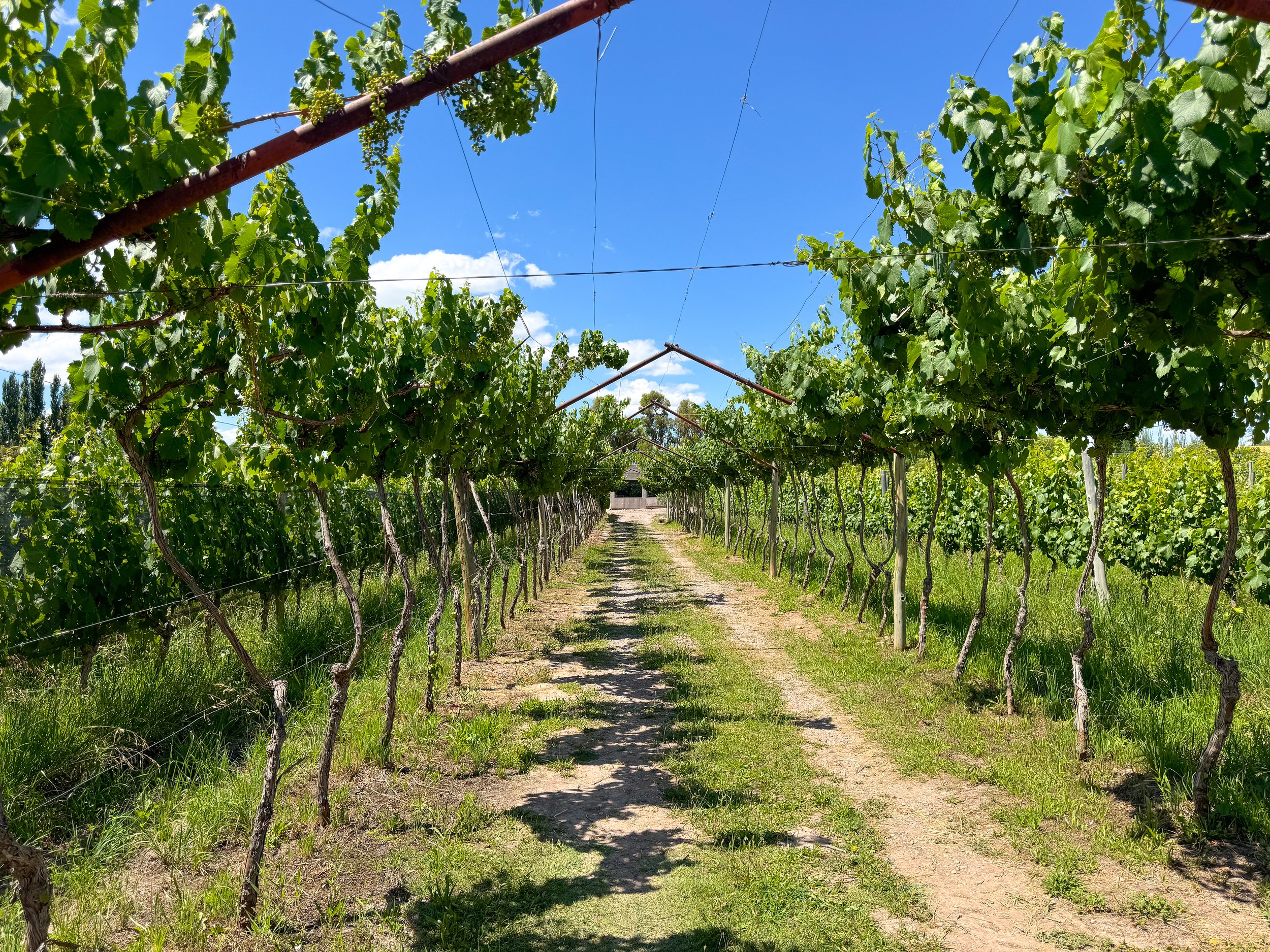
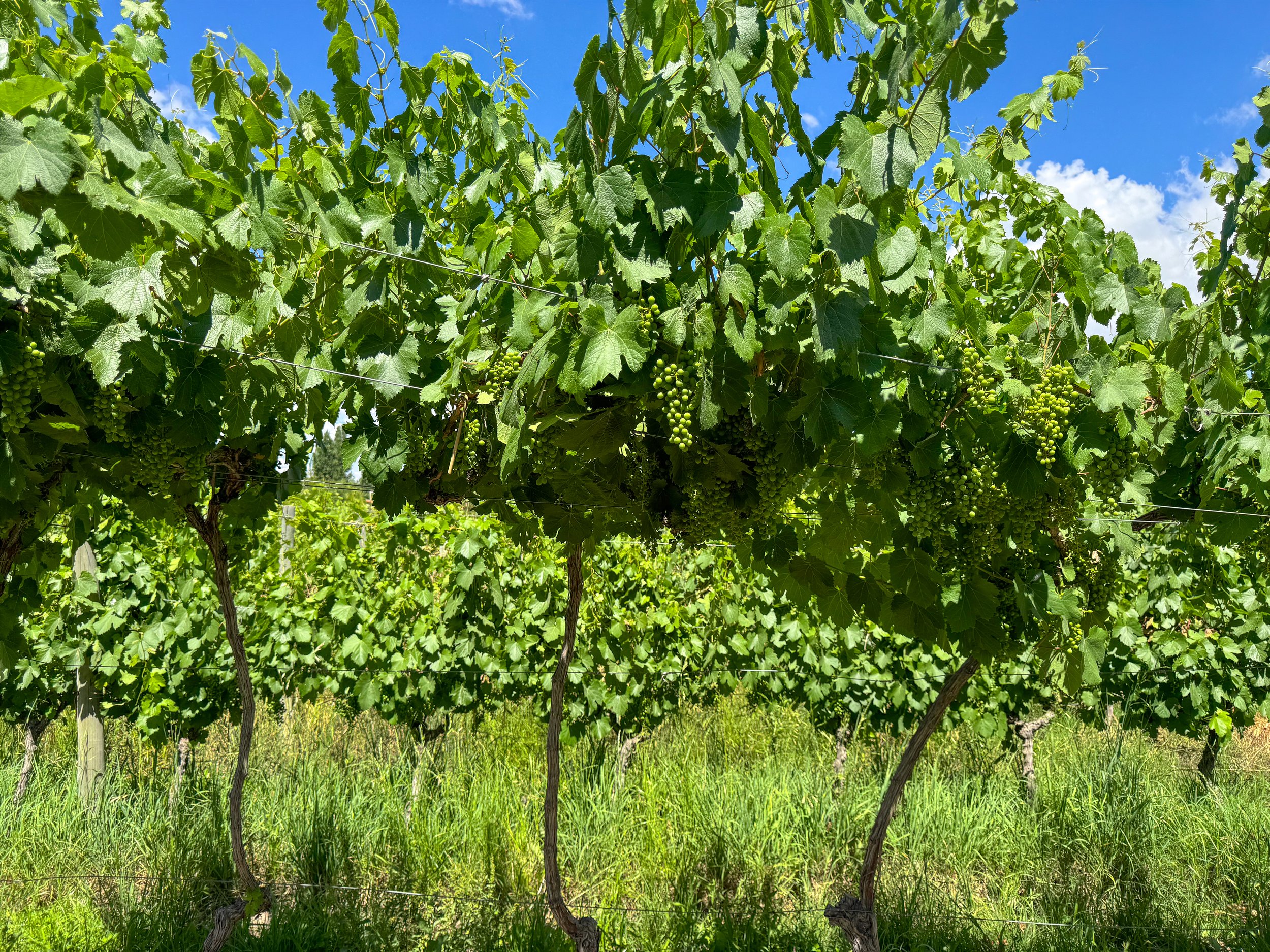
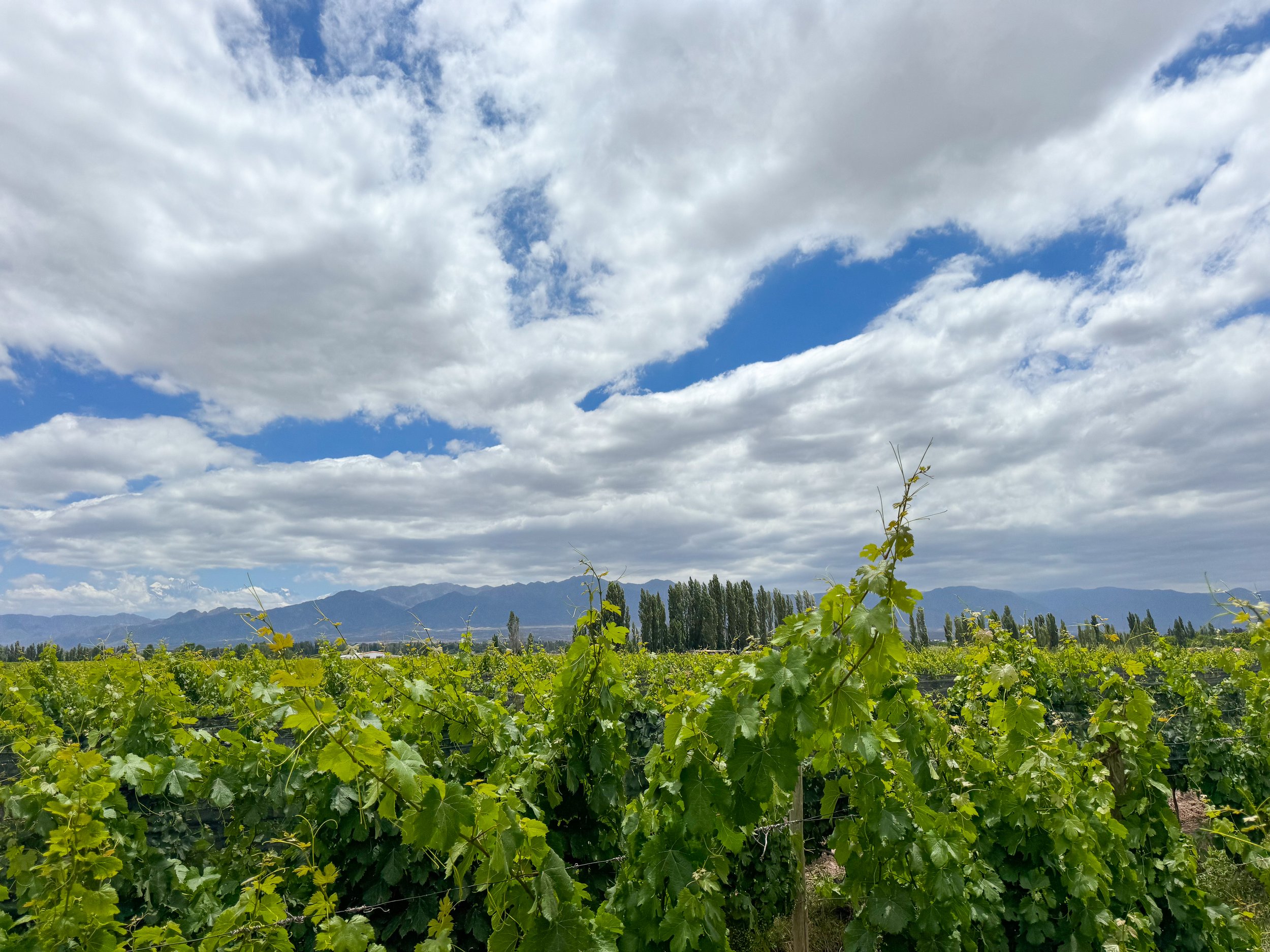
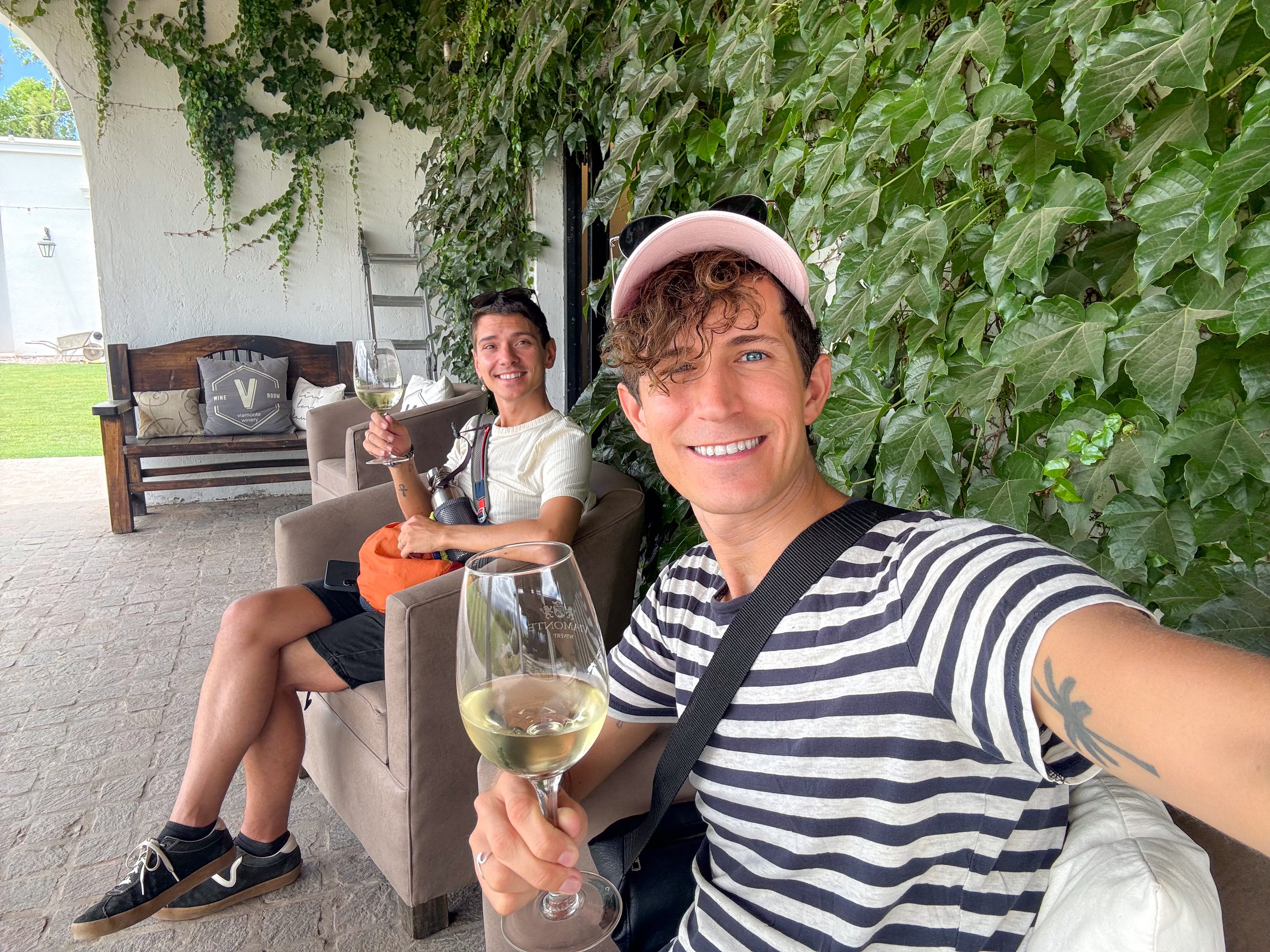

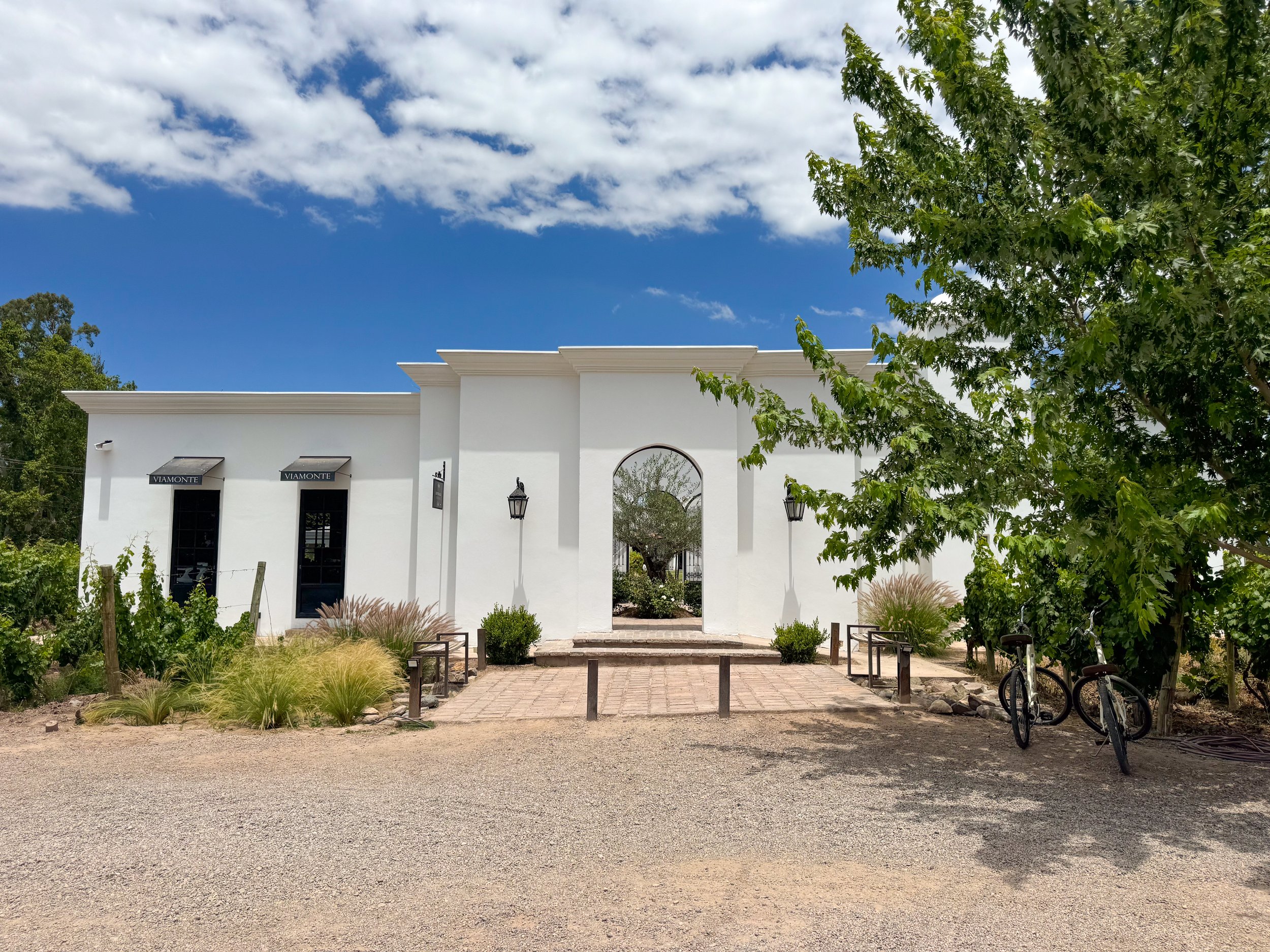
Lujan de Cuyo
A beautiful valley with grand vineyards, country homes and views of the Andes located south of Mendoza. It has defined and well maintained sidewalk style bike paths that lead directly to most vineyards. We had a lazy day, only visiting two vineyard while enjoying the scenery and wines.
Bodega Gieco. A rustic vineyard with a tasting room, provisions shop, bakery and range outdoor seating areas. We tasted three wines: Malbec, Cabernet Franc and Tannat. We enjoyed our first glass on their elevated deck overlooking the rows of grape vines in vineyard with a house baked vegan ciabatta sandwich. We sipped on the second two in their patios covered with fruiting apricot trees. The vineyard is bike friendly and no reservation is needed.
Bodega Viamonte. A very elegant vineyard with seemingly endless rows of grape vines and views of the snow covered Andes. We arrived early and ordered a glass of rosé paired with a chocolate moose pastry. The tour began with a glass of their house white, a walk through the vineyard and white brick processing facilities. We ended in their tasting room surrounded by oak barrels of aging wines. Our tasting included four Malbecs, two entry level, one reserve and grand reserve paired with a chocolate tart, tomato moose cracker and blue cheese. The vineyard is bike friendly and reservations are required.
City Winery
Bodega Las Toneles. A massive winery in the city with historic buildings housing giant concrete containers, steel tanks and stacked oak barrels of aging wine. We tasted a Merlot directly from a stainless steel tank and sampled glasses of Pinot Noir, Rosé, Sauvignon Blanc and two Malbecs. The most exciting part of the tour is the extravagant underground wine vault with painted mermaids swimming in tanks of wine. The winery has a pastel colored cafe, a Michelin stared restaurant and event venue.
Central Mendoza
The city center of Mendoza is a hub for cuisine and wine with restaurant lined streets, tree covered promenades, empanaderas, produce markets and daily happy hours.
Calle Arístides Villanueva. A tree covered street with many restaurants, bars, cafes and breweries popular with both locals and tourists, especially after 8pm. Come here to dine at one of the street patios or high-end restaurants.
Peatonal Sarmiento. A tree covered pedestrian street with cafes, wine shops, restaurants and shopping.
Mercado Central. A historic market with vendors selling wine, olives, bread, meats, cheese, seafood, empanadas, alfajores and produce.
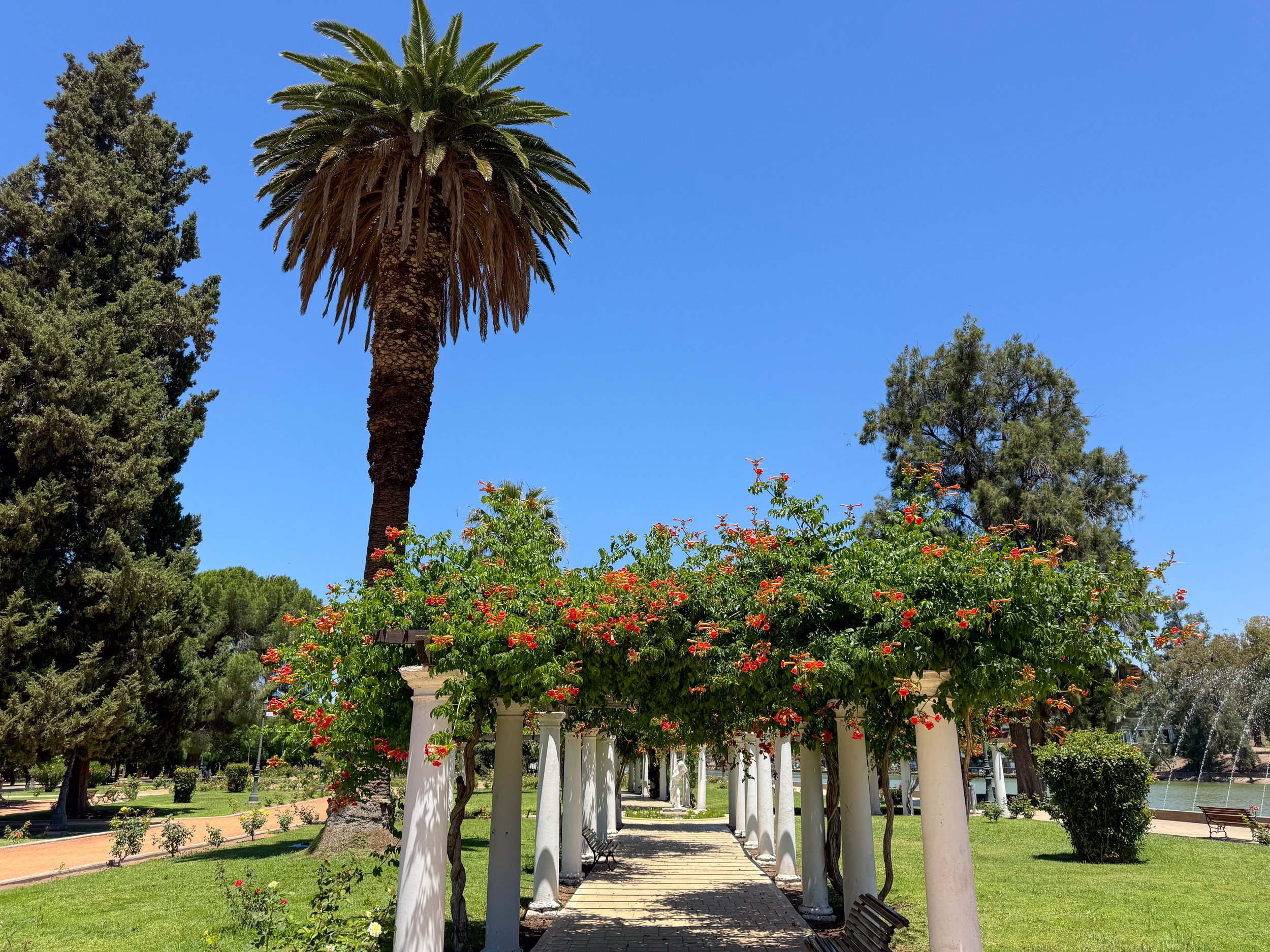
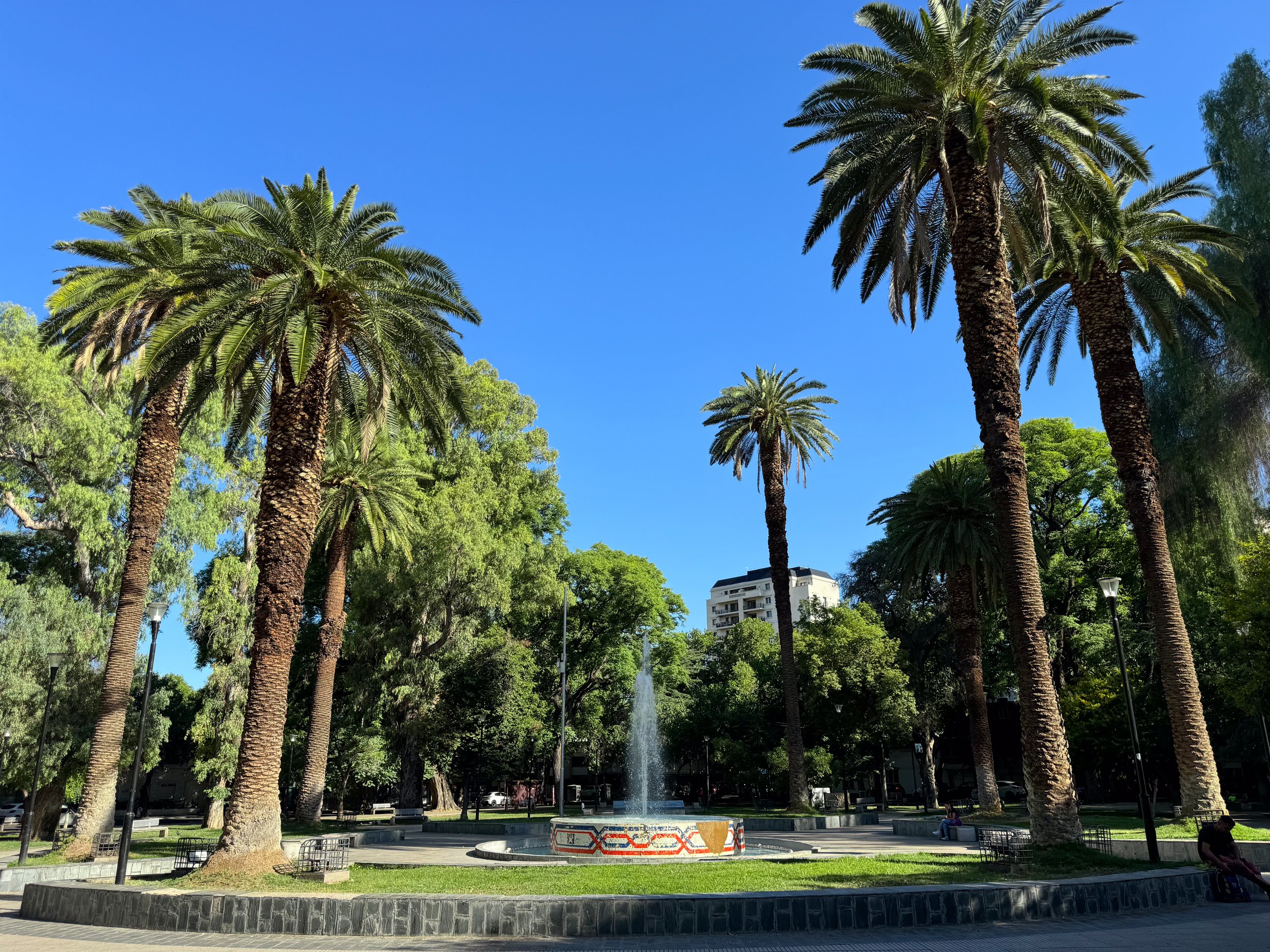
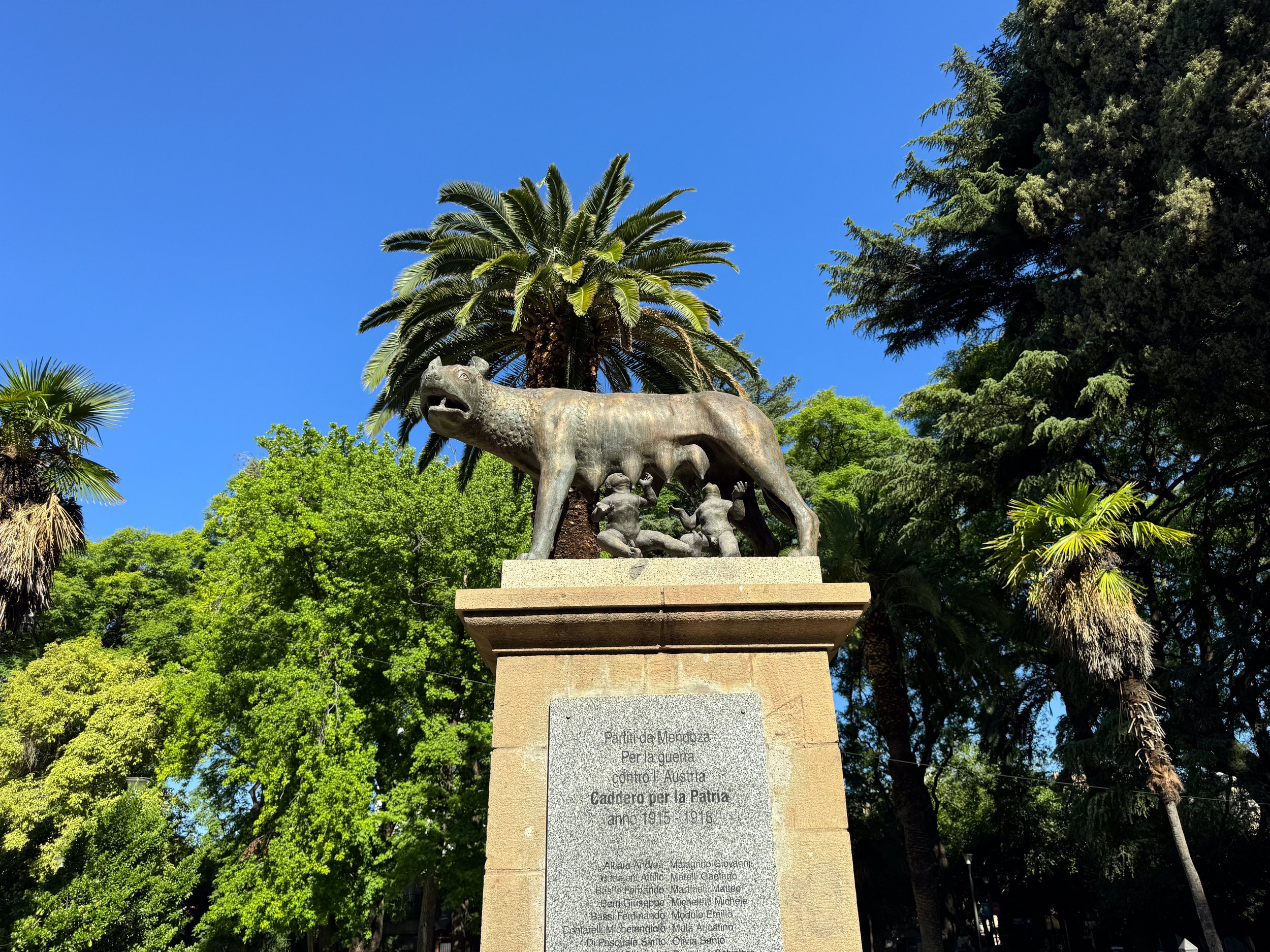
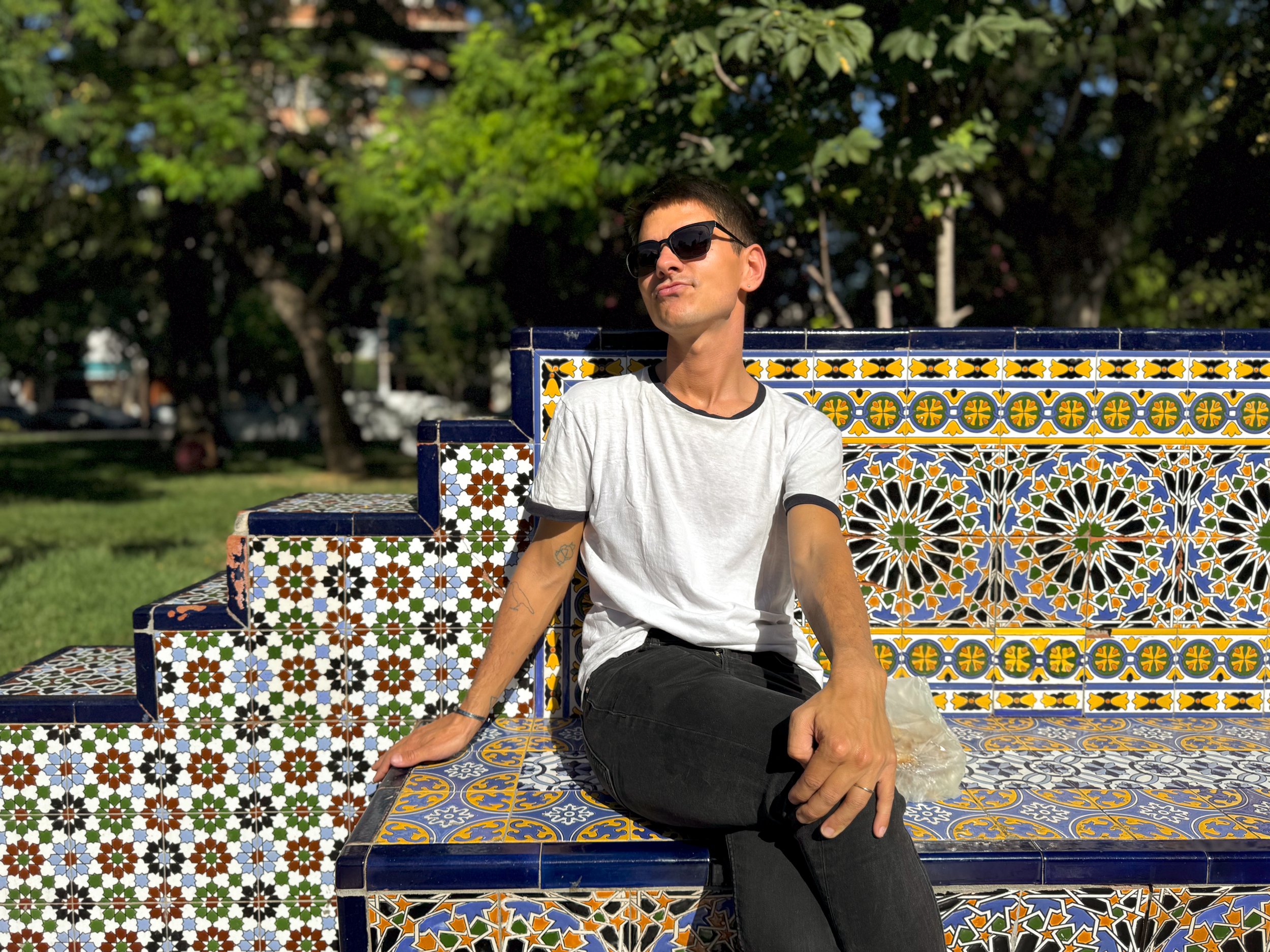
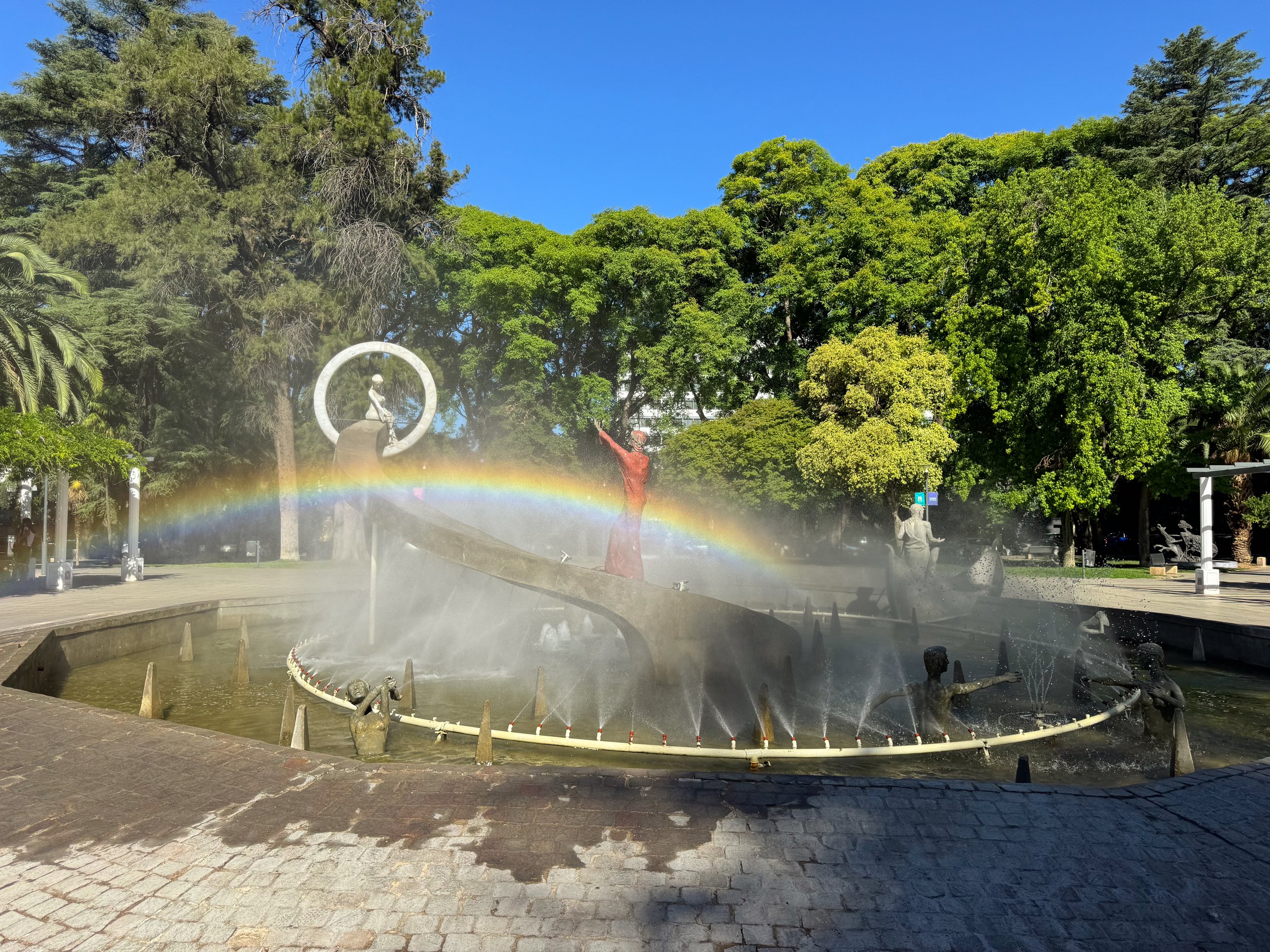
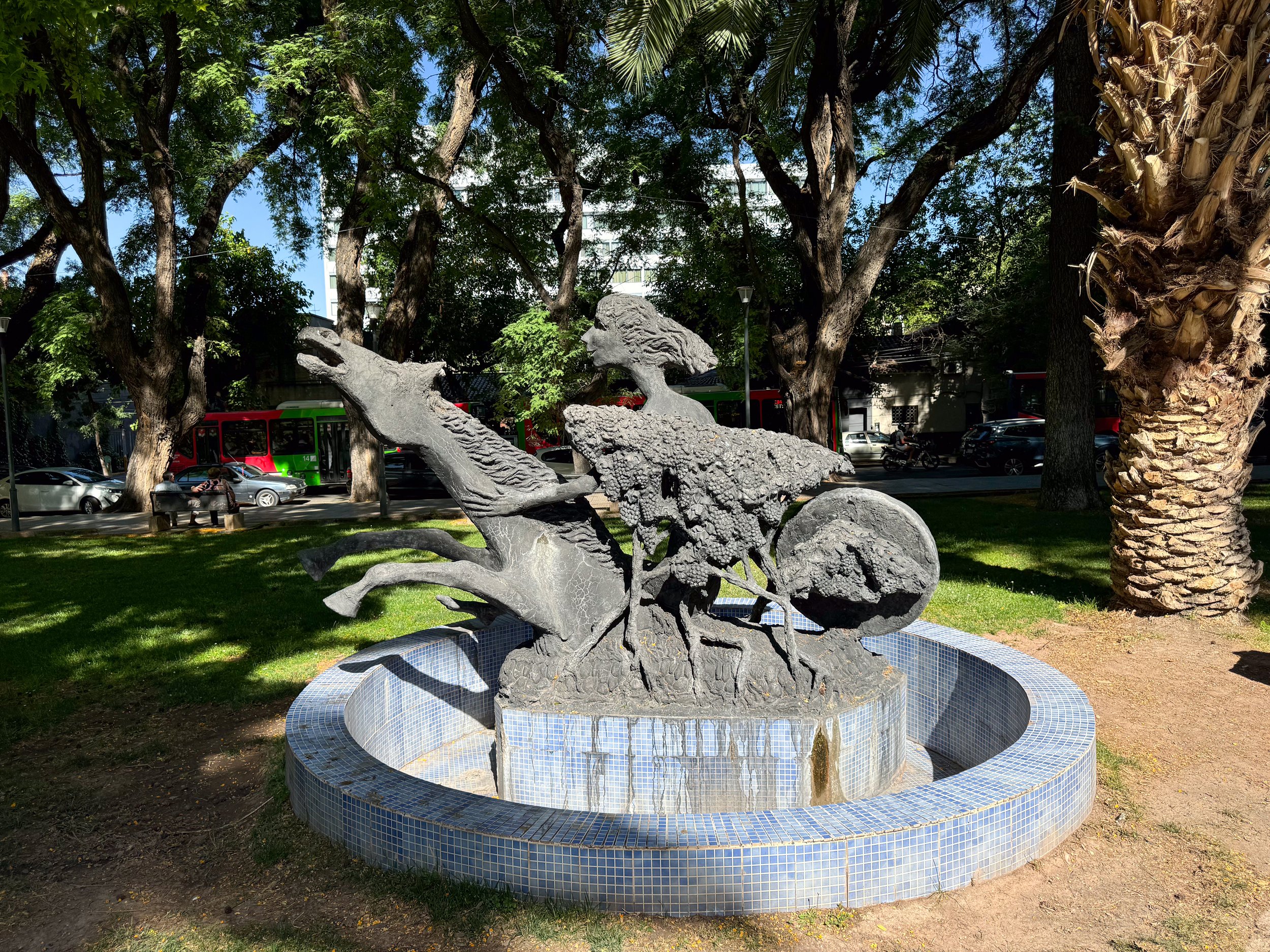
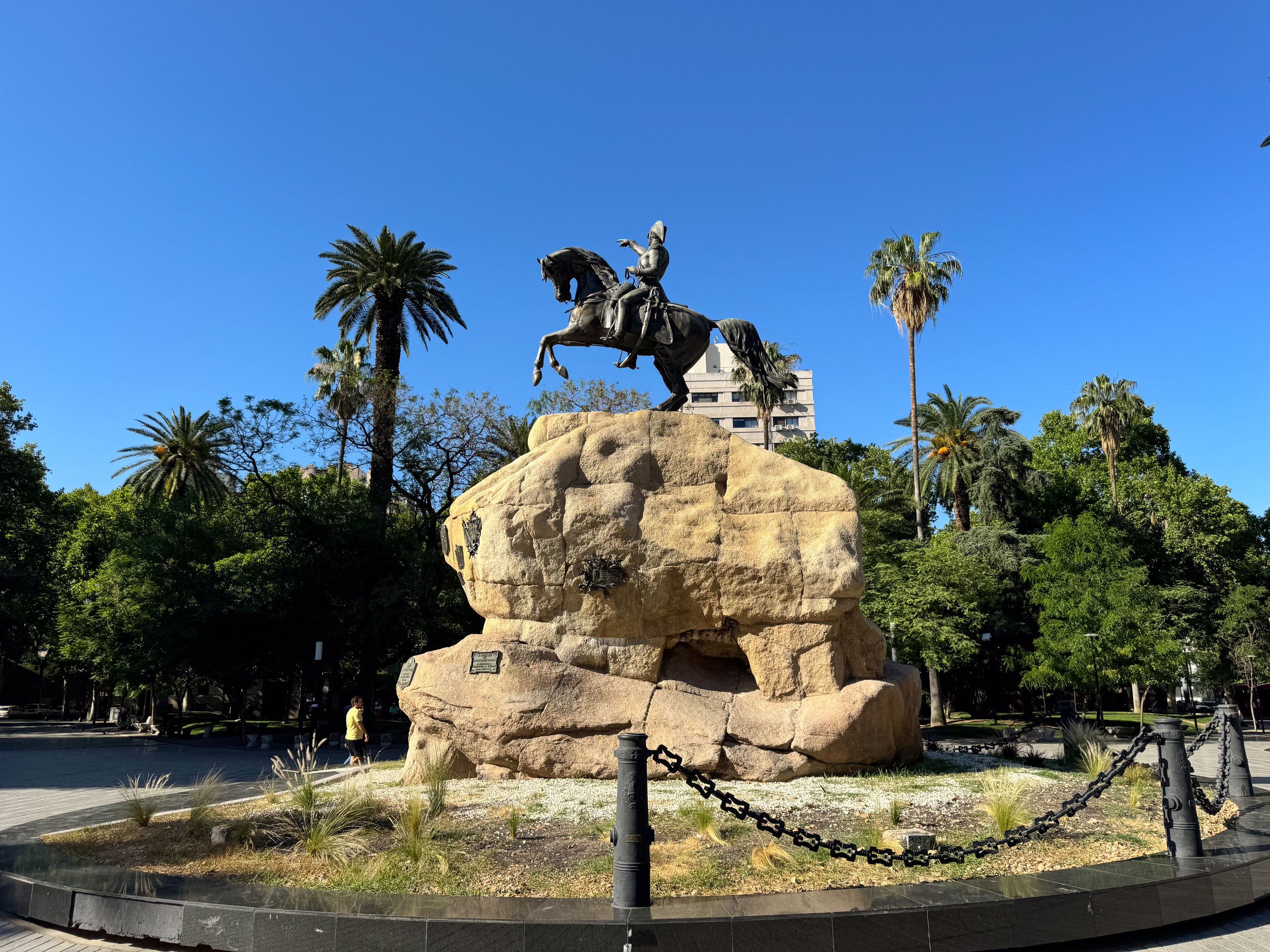
City Plazas and Parks
The city center is organized around a large plaza with four smaller squares a few streets away from its corners. They’re all easy to visit on foot and worth exploring while walking around the city center.
Plaza Independencia. A large treelined square at the center of the city with fountains, a theater and a weekend artisan market. Venders sell handcrafted items like wire metal jewelry, knitted items, leather good, ceramics, watercolor paintings, and knives.
Plaza España. A beautiful plaza with a central fountain, park benches, a monument and walkways covered in colorful and ornate Spanish tiles.
Plaza Italy. A plaza dedicated to Argentina’s Italian immigrants with a fountain at its center telling the story of Dante’s Divine Comedy, a statue of Rome’s iconic wolf, Lupa and numerous others rooted in Italian history.
Plaza Chile. A plaza dedicated to Argentina’s close relationship with neighboring Chile. The plaza has a fountain and park benches covered in mosaic tiles in the colors of Chile’s flag.
Plaza Army. A plaza dedicated to Argentina’s army with a stone monument and a bronze statue of a bronze general riding on top of it.
Parque San Martin. A large city park with a central pond, rose garden and biking trails. We picnicked here on a Saturday, walked along the trails and visited a large tented craft market and small organic food market.
Empanada Crawl
Empanadas are one of Argentina’s most popular snacks. The savory packets of dough are stylized with crimped sides and stuffed with fillings including meats, veggies or seafood. We decided to make a meal out of them and go on an empanada crawl across the city, trying as many vegetarian and pescatarian flavors as possible from multiple restaurants.
Los Inmigrantes - Sucursal Ciudad. A pizza parlor and empanadaera with several types of baked empanadas. We tried four types, the corn with cheese, shrimp with cheese, onion with cheese and spinach with onion. They had a homemade look and taste to them.
Harry’s. A chain restaurant and empanadera with a countertop display of dozens of empanadas ready to order. We visited two locations, trying the tuna, sweet corn, corn with cheese and fried shrimp with cheese. They had a homemade look and taste to them.
De un Rincón de la Boca. A pizzeria with pizza flavored empanadas on the menu. Most have meat however we tried the one veggie option, the capresse. The dough wrapped a tasty filling of tomato, mozzarella and basil.
Costumbres Argentinas. A fast food style deli with deserts, sandwiches and of course empanadas. We tried the vegan version with seasoned soy protein and another stuffed with corn, onion and cheese. They looked a little sad and tasted the most processed.
Have a Picnic!
We visited the Mercado Central and bought an assortment of goodies to create our own Picada style picnic. From the various vendors, we bought a bottle of Malbec, baked empanadas, green olives, fresh apricots, cherry tomatoes, a triangle of cheese, dried breads and alfajores. We brought our spoils to a shaded spot overlooking the lake in Parque San Martin and enjoyed for the afternoon.
What to Eat & Drink
Outside of empanadas, wine and meat, Argentina has a few more popular staples of their cuisine.
Picadas. Argentinian style charcuterie or plates of pickings “pickings” often including cheeses, pickled veggies and meats.
Rabas. Fat rings of Argentinian style fried calamari. It’s a common restaurant appetizer and snack at bars.
Milanesa. The classic Italian dish of a breaded and fried protein is popular across Mendoza. Unable to find a vegetarian version, we made our own Eggplant Milanese with a tomato and onion sauce.
Medialunas. Sweet Argentine style croissants often served at breakfast.
Alfajores. Two sugar cookies with a generous layer of dulce de lèche sandwiched in between and coated in coconut shavings or covered in chocolate.
Olives. In addition to grape vineyards, olive groves are plentiful across the region. Pickled olives, olive pate and olive oils are common snacks and ingredients on menus.
Fugazza. Argentinean style pizza made with a thin crust and fluffy dough topped with any number of toppings. Traditional places bake it in a coal or wood fired oven.
Provoleta. Grilled and melted Argentinean provolone cheese seasoned with oregano and olive oil It’s often served with bread for dipping.
Local Beer. Outside of wine, Mendoza has a small beer scene with breweries, beer gardens and local beers.
Cerveza Patagonia. An Argentinian brewery with a range of locally brewed beers. We ordered the Vera IPA, a mildly hoppy and citrusy beer, and the Lager del Sur, an easy drinking beer with a slight sweetness.
Chachingo Arístides. A craft beer garden with a menu of locally brewed beers. We tried the Blonde Ale, light and refreshing, and IPA, mild and hoppy.
Andes Origen. A local brand of beer with several varieties. It’s advertised and seen on menus across the city. We tried the Roja, a light and nutty flavor with a slight sweetness.
Where to Eat & Drink
Soberana. One of the fancier restaurants in the town in a contemporary building. We ordered the buratta, basket breads and seafood pasta to share.
Che Picadas. A restaurant serving Picadas (Argentinian style charcuterie). They provide a platter of them for free with any order of food! We ordered the classic spread for two with a Spanish tortilla, six caprese empanadas and rabas (calamari).
Zitto. A chain restaurant and bar with a 2x5 happy hour. After walking around, we cooled down and relaxed with two Aperol Spritz.
Va Vene. A cafe chain with locations across the city with alfajores, frozen pasta and coffee.
La Dolce. A house in the Maipu Valley converted into a cafe with artisan coffee and sweet breakfast dishes like medialunas, waffles and pancakes. Try the waffles covered in dulce de lèche and sliced bananas.
Safety & Good to Know
Mendoza is generally safe however petty theft, pickpocketing and snatch and grabs can happen. Keep phones and wallets in front pockets while walking around and never sitting on the table or bar when dining out.
Outside of vineyards, most places only serve wine by the bottle though there’s typically a house red and white by the glass.
When dining out, glasses of wine and occasionally bottles are cheaper than cups of coffee.
Credit and debit card is widely accepted.
Tipping is almost always done in cash. 10% is the generally accepted amount.
Many restaurants don’t open for dinner until after 8pm.
The city center is very walkable but use Ubers or taxis for longer distances.
For Next Time…
Tour the Uco Valley. A wine producing region about an hour south of Mendoza with vineyards and wine tours.
Nature Sights. Outside of visiting vineyards and drinking wine, we would return to see some of the regions natural sights including:
Parque Provincial Aconcagua. An Andean park with the tallest mountain in the Southern and Western hemispheres. On a clear day, it’s visible from Mendoza.
Lago Potrerillos. A deep blue reservoir in the foothills of the Andes Mountains with boating, hiking and watching the sunset.








